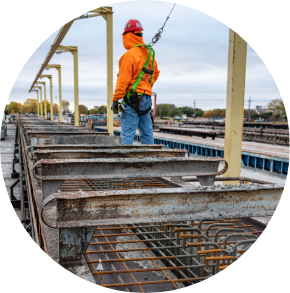Welded Wire 101

What Is Welded Wire Reinforcement?

How Welded Wire Reinforcement (WWR) Is Made
- Controlled-quality, hot-rolled smooth rods are cold-worked through a series of dies or cassettes to reduce the size, resulting in wires of project-specific diameter with higher yield strength.
- Wire intersections are electrically resistance-welded by automatic machines.
- Pressure and heat fuse the interacting wires together into a homogeneous section and into fixed position. No consumable electrode material is used in the welding process.
Why WWR is Necessary
A reinforcing steel material is used in structural concrete due to the concrete material’s inherently low tensile strength. An appropriate amount of reinforcing steel, which itself is well-suited for resistance to tensile force, is strategically positioned in concrete so that both compressive and tensile effects are predictably resolved through strain-compatible behavior. Concrete reinforced with high yield strength WWR is characterized by a composite interaction between the two bonded materials, the computational routines for which are historically well-documented in design codes and intuitively calculated by the engineering design professional.
Welded wire reinforcement provides a tensile bridging effect when it is properly bonded within the concrete to each side of a developing crack. This is done through the specification of a cross-sectional area of steel, proportioned and intentionally positioned as part of the engineer’s design. The basic tenet of reinforced concrete design is to ensure that a sufficiently ductile response can be achieved in an overload scenario through the development of large tensile strains, all while limiting excessive and unsightly crack sizes at service level operation of the structure.
Watch our video to learn more about the basics of using welded wire reinforcement.
The Benefits of WWR
- Strong
WWR is available in yield strengths up to 80 ksi - Fits Exact Size
Wires can be welded in various sizes and spacings, and pre-bent to suit - Versatile
WWR can be used in a variety of industries - Wires in Position
Welding into a mat makes sure wires stay in place

